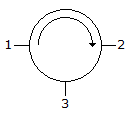Discussion
Home ‣ Electronics and Communication Engineering ‣ Microwave Communication See What Others Are Saying!
- Question
In a three cavity klystron amplifier, the oscillations are excited in
Options- A. input cavity
- B. output cavity
- C. intermediate cavity
- D. both (a) and (b)
- Correct Answer
- intermediate cavity
ExplanationA Klystron is a vacuum tube used for generation/amplification of microwaves.An electron beam is produced by oxide coated indirectly heated cathode and is focussed and accelerated by focussing electrode.
This beam is transmitted through a glass tube. The input cavity where the beam enters the glass tube is called buncher.
As electrons move ahead they see an accelerating field for half cycle and retarding field for the other half cycle.
Therefore, some electrons are accelerated and some are retarded. This process is called velocity modulation.
The velocity modulation causes bunching of electrons. This bunching effect converts velocity modulation into density modulation of beam.
The input is fed at buncher cavity and output is taken at catcher cavity.
In a two cavity klystron only buncher and catcher cavity are used. In multi cavity klystron one or more intermediate cavities are also used.
The features of a multicavity klystron are :
1. Frequency range - 0.25 GHz to 100 GHz
2. Power output - 10 kW to several hundred kW
3. Power gain - 60 dB (nominal value)
4. Efficiency - about 40%.
A multicavity klystron is used in UHF TV transmitters, Radar transmitter and satellite communication.
More questions
- 1. As compared to dimensions of most feeds, the skin depth at microwave frequencies is
Options- A. of the same magnitude
- B. much larger
- C. much smaller
- D. either (b) or (c) Discuss
Correct Answer: of the same magnitude
- 2. For a 1 cm x 2 cm air filled rectangular waveguide the maximum frequency should be less than about
Options- A. 1000 MHz
- B. 5000 MHz
- C. 14000 MHz
- D. 140000 MHz Discuss
Correct Answer: 14000 MHz
- 3. In a radio receiver
Options- A. all stages contribute equally to noise
- B. RF stage has no effect on S/N ratio
- C. mixer stage contributes most of the noise generated Discuss
Correct Answer: mixer stage contributes most of the noise generated
- 4. As compared to an ordinary semiconductor diode, a Schottky diode
Options- A. has higher reverse saturation current
- B. has higher reverse saturation current and higher cut in voltage
- C. has higher reverse saturation current and lower cut in voltage
- D. has lower reverse saturation current and lower cut in voltage Discuss
Correct Answer: has higher reverse saturation current and lower cut in voltage
Explanation:
This is due to high electron concentration in metals.- 5. A 3 port circulator is in the given figure. Its scattering matrix is

Options- A.

- B.

- C.

- D.
 Discuss
Discuss
Correct Answer:
- 6. The total field developed by an antenna array at a distant point is
Options- A. phasor sum of fields produced by individual antennas of the array
- B. algebraic sum of fields produced by individual antennas of the array
- C. either (a) or (b) depending on type of array
- D. neither (a) nor (b) Discuss
Correct Answer: phasor sum of fields produced by individual antennas of the array
Explanation:
Since field is a phasor quantity we have to take phasor sum.- 7. A standard cell of 1.0185 V is used with a slide wire potentiometer. The balance was obtained at 60 cm. When an unknown emf was connected, the balance was obtained at 82 cm. The magnitude of unknown emf is
Options- A. 1.39 V
- B. 0.75 V
- C. 13.9 V
- D. 7.45 V Discuss
Correct Answer: 1.39 V
Explanation:
 .
.
- 8. The number of valence electrons in donor impurity are
Options- A. 5
- B. 4
- C. 3
- D. 1 Discuss
Correct Answer: 5
Explanation:
Donor impurity has 5 valence electrons (while silicon has 4 valence electrons).Hence donor impurity can donate electrons.
- 9. Assertion (A): A DIAC has four layers but only two terminals.
Reason (R): A DIAC can conduct in both directions.
Options- A. Both A and R are correct and R is correct explanation of A
- B. Both A and R correct but R is not correct explanation of A
- C. A is correct but R is wrong
- D. A is wrong but R is correct Discuss
Correct Answer: Both A and R correct but R is not correct explanation of A
- 10. A NAND gate has 3 inputs and one output. The number of thyristors required for this gate are
Options- A. 1
- B. 2
- C. 3
- D. 3 or 4 Discuss
Correct Answer: 3
Comments
There are no comments.
More in Electronics and Communication Engineering:
Programming
Copyright ©CuriousTab. All rights reserved.
